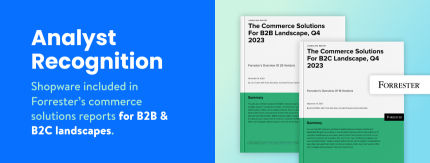
We are all now aware that commerce tech presents a world of opportunity for brands. A commerce solution isn’t just a single solution to an immediate challenge; it is often able to address a range of future use cases that can open new avenues for the business.
But to carry out a robust evaluation and understand how to get the most out of commerce solutions, companies need to know who the main providers are, as well as their key use cases.
Two recent reports from Forrester neatly map out what the commerce solution landscape looks like, so buyers can make informed decisions about vendors suitable for their needs. The Commerce Solutions For B2B Landscape, Q4 2023, and The Commerce Solutions For B2C Landscape, Q4 2023 define the market maturity and dynamics of the sector, with a brief overview of the notable vendors.
Why do landscape reports matter for buyers? According to the Forrester B2C report, three-quarters of B2C companies select a vendor to meet their commerce needs, versus the 25% who build their own bespoke system. There is a clear need for expertise in the sector – but who are the experts in helping businesses select the right vendor for their needs?
The B2C report, authored by Forrester Principal Analyst Emily Pfeiffer, defines the solution market maturity and dynamics with a brief overview of vendors. While these reports are not a ranking of top vendors in the market (see Forrester Wave [TM] or Gartner’s Magic Quadrant), they do outline how vendors address these major trends.
Forrester asked each vendor included in the Landscape reports to select the top use cases for which clients select them and, from there, determined which are the extended use cases that highlight differentiation among the vendors. The reports list vendors for having selected various use cases as top reasons why clients work with them out of those extended use cases.
Finding a solution that meets today’s B2C challenges
In the B2C sector, Forrester identifies that the market is dominated by SaaS solutions. This reflects the demand from B2C commerce practitioners and developers for increased efficiencies and flexibility. They want solutions they can scale up or down to suit their needs and market conditions and to make sure that they are making the most of their internal resources, such as staffing.
Another key trend is iterative change. We’re no longer in the realm of the ‘big bang digital transformation’ with a wholesale overhaul of platforms and capabilities – rather, solutions are now added according to need, and digital leaders prioritize solutions with a shorter time to value. Clearly, economic conditions are heavily influencing buying preferences, with quick proof of ROI, minimal technical debt, and change management all top of mind. The Forrester B2B report also identifies the top disruptive trend in the sector as real-time personalization.
With many businesses still struggling to unify customer data and then feed it to the essential systems across departments for a 360-degree customer view, we at Shopware also believe that real-time personalization is a top disruptor.
The differentiation challenges in B2C
From our experience, we see that vendors are attempting to tackle the major market trends by either specializing or adopting a more generalist approach. Generalists find it more difficult to differentiate themselves because basic functions such as the shopping cart are highly commoditized.
In the reports, a handy table clearly demonstrates which three extended use cases each vendor selected as top reasons their customers work with them. Again, while this Forrester B2C report does not rank vendors, please feel free to remark that Shopware is the only vendor in the report that selected the combination of the three following use cases:
Improve efficiency for users and automate work
Create an integration hub for adjacent tech
Order entry outside typical online shopping
But why do clients choose us for these use cases?
Automation tools like Flow and Rule Builder enhance efficiency in their day-to-day business so they can focus on what’s most important – their customers.
Shopware’s extensive ecosystem of technology and integration partners ensures limitless extensibility. Through interfaces and APIs, merchants can extend their system indefinitely with solutions from the Shopware Store or custom-made options thanks to the open source architecture and culture.
Differentiating the buying journey and offering a personalized, interactive, yet digital shopping experience is no longer a challenge with Shopware’s revolutionary feature Digital Sales Rooms. The state-of-the-art virtual shopping solution empowers merchants to create seamless, immersive, and highly engaging online shopping experiences with live video consultation and curated digital offers to drive sales and reduce overhead costs.

Helping the B2B market understand its potential
In the B2B market, the Forrester report suggests that buyers aren’t necessarily confused by which use case to target but by the vendor’s marketing. The recent hype around the concept of composable technology has confused buyers. They don’t understand the benefits of composable solutions, and vendors have been too quick to use the terminology, effectively turning their potential customers off.
Before they are swept into promoting their offerings using tech buzzwords, vendors need to concentrate on selling their solutions based on their potential customers' actual needs, in particular, offering flexibility to tailor that product to their specific needs. The B2B report, authored by Forrester Principal Analyst Joe Cicman, states: “The requirements for B2B commerce are far from homogenous.”
Indeed, we think that promoting products or strategies based on today’s hot topics won’t necessarily speak to clients’ real needs. There’s no escaping the AI hype, for example, and many solutions – Shopware included, with AI Copilot – have a range of advanced AI capabilities.

The report identifies AI as a “top disruptor,” but Shopware’s findings show that the landscape will need to undergo some maturing and show real business impact before the mainstream begins adopting it at scale. That said, customers should keep an eye out for future-fit vendors today so they don’t end up playing catch-up tomorrow.
Proof of concept is increasingly the way clients want to approach selecting new commerce solutions. Instead of the more traditional RFP, Forrester’s report author recommends “hands-on prototyping” for vendor selection.
The differentiation challenges in B2B
Forrester identifies the top use cases for B2B commerce solutions as distributors selling physical goods or manufacturers selling physical goods, which favours vendors who have focused on those sectors. Appropriately, the healthcare, manufacturing, and wholesale industries are identified in the Forrester report regarding the industry focus areas Shopware reported.
Furthermore, Shopware selected the following extended use cases in B2B commerce as top reasons clients work with them:
Selling aftermarket parts
Professional services
Franchise webstores
Selling aftermarket parts in the manufacturing sector, for example, is one of our strongest verticals. Take REIFF Technische Produkte GmbH, one of the largest suppliers of technical products in Germany. Shopware helps it manage its 80,000 products across eight locations, both through online stores and marketplaces such as Mercateo.

With B2B organizations keeping a close eye on the bottom line and margins tighter than ever, they’re also looking for professional services that support rather than erode those margins further. Additional key benefits, particularly important for B2B merchants, include the ability to offer digital and physical goods or services in the same shopping experience. Moreover, merchants can generate unique SKUs and prices based on various factors (for example, in combination with the Rule Builder and Flow Builder). Additionally, Shopware will release another function in 2024 that will give B2B merchants even more control over their margins.
Flexibility remains key, however, with B2B consumer needs changing as rapidly as B2C ones. Providing franchise webstores helps B2B organizations respond to those needs, whether that’s with multiple currencies, configured pricing, multi-language, or payments.
B2B commerce is increasingly mimicking B2C by adopting an omnichannel strategy, so being able to orchestrate sales across a wide variety of channels will be vital. As Forrester summarizes in their B2C report: “When digital routes to market are plentiful, and buy buttons are everywhere, the mission of differentiating your business will push you to solve more of your business customers’ problems.”
If you would like to learn more about various vendors, including Shopware, and how to meet the changing and challenging use cases of today’s B2C and B2B commerce organizations, download and read the relevant, complimentary Forrester reports here:










